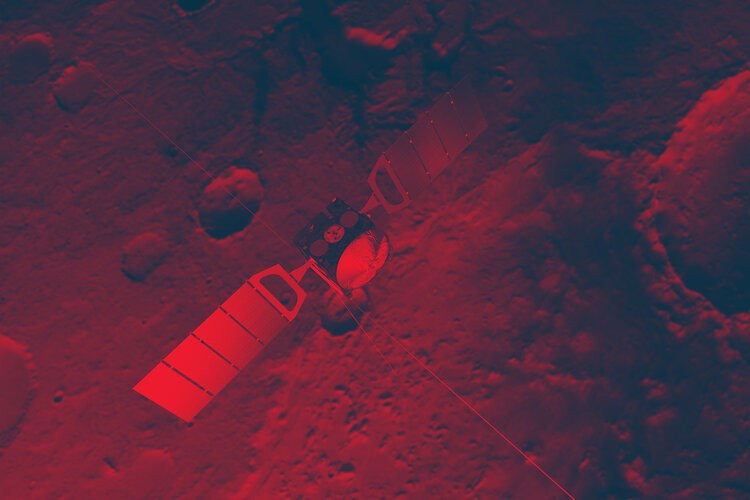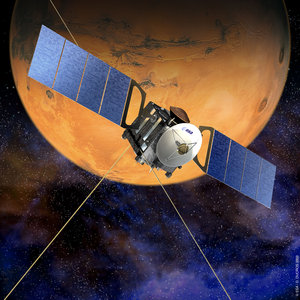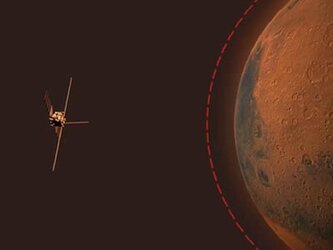Mars radar opens up a planet’s third dimension
ESA’s Mars Express radar sounder, MARSIS, has looked beneath the martian surface and opened up the third dimension for planetary exploration. The technique’s success is prompting scientists to think of all the other places in the Solar System where they would like to use radar sounders.
No matter how accurate a camera is, it can only map a planet’s surface. To retrieve information about the underground realm, planetary scientists in the past would have thought it necessary to land on the surface and start digging.
But that would only be good for a single spot on a large planet and the first few decimetres of the surface. To get the global picture of the subsurface they need a radar sounder, such as the Mars Advanced Radar for Subsurface and Ionosphere Sounding (MARSIS), to find the best spots for the future landers to go and dig.
MARSIS is built to map the distribution of liquid and solid water in the upper portions of martian crust. If reservoirs of water are detected, it will help us understand the hydrological, geological, climatic and possibly biological evolution of Mars. The radar experiment works because every time a radar wave crosses a boundary between different substances, it generates an echo that the orbiter detects.
A successful experiment

MARSIS was an experiment in every sense of the word. “It was a leap into the unknown,” says Ali Safaeinili, MARSIS co-investigator at the Jet Propulsion Laboratory (JPL), California, USA.
No one had ever used a radar sounder from orbit on another planet before. So the team could not even be sure whether it would work as planned. The subsurface of the planet might have been too opaque to the radar waves or the upper levels of martian atmosphere (ionosphere) might have distorted the signal too much to be useful. Thankfully, none of this happened.
“We have demonstrated that the polar caps at Mars are mostly water ice, and produced an inventory so now we know exactly how much water there is,” says Roberto Orosei, MARSIS Deputy Principal Investigator, IASF-INAF, Italy.
While MARSIS is still collecting data, a follow-up instrument is already operating at Mars. The Shallow Subsurface Radar (SHARAD) on NASA’s Mars Reconnaissance Orbiter works at higher frequencies than MARSIS and can see more details in the signals it receives from the underground layers, at the cost of shallower penetration.
Elsewhere in the Solar System...

Armed with a better understanding of how planetary radar sounders work, the MARSIS team is beginning to look further afield in the Solar System, to other bodies that might benefit from radar investigation. One obvious target is Jupiter’s icy moon, Europa.
A MARSIS-type experiment in orbit around Europa could probe its icy crust to help understand the puzzling features we see on the surface. It may even see the interface at the bottom of the ice where an ocean is expected to begin. “At the south pole of Mars, we are seeing through ice 3.7 km thick. A small calculation shows that we could see through ice down to 20 km or more thick at Mars,” says Safaeinili.
At Saturn’s moon, Titan, penetrating radar could be used to measure the depths of the hydrocarbon lakes that the Cassini spacecraft has detected. It could also probe the structure beneath the enigmatic geysers that Cassini has observed on another one of Saturn’s satellites, Enceladus. “Radar sounders are very well suited to exploring icy worlds,” says Orosei.

But not just for icy moons. Asteroids and comets could be thoroughly scanned by a radar sounder, producing three-dimensional maps of their interior– perhaps exactly the data we will need if, one day, we have to nudge one out of Earth’s way.
MARSIS has served as an excellent example of international collaboration between Europe and America. Increasingly, such collaborations are set to become a positive feature of our joint exploration of space.
Likewise, radar sounding will become an essential component of future planetary missions. In the near term, planetary scientists can look forward to more results from MARSIS. “The analysis is not concluded yet,” says Orosei. In fact, while MARSIS is still collecting data, everyone concerned expects more surprises.
Notes for editors:
Mars Express has been orbiting the red planet since December 2003. It carries seven scientific experiments, including MARSIS. The primary purpose of MARSIS is to investigate the subsurface of Mars up to a depth of 5 km in order to detect buried materials, such as water ice or liquid. It is the first instrument ever designed to actually look below the surface of Mars.
MARSIS was developed jointly by the Italian Space Agency and NASA, under the scientific supervision of the University of Rome 'La Sapienza', in partnership with JPL and the University of Iowa, USA. The Shallow Subsurface Radar on NASA's Mars Reconnaissance Orbiter was provided by the Italian Space Agency (ASI). Its operations are led by the University of Rome and its data is analysed by a joint U.S.-Italian science team.
For more information:
Ali Safaeinili, MARSIS Co-Investigator, Jet Propulsion Laboratory, USA
Email: Ali.Safaeinili @ jpl.nasa.gov
Roberto Orosei, Deputy Principal Investigator, IASF-INAF, Italy
Email: Roberto.Orosei @ iasf-roma.inaf.it
Agustin Chicarro, ESA Mars Express Project Scientist
E-mail: Agustin.Chicarro @ esa.int














